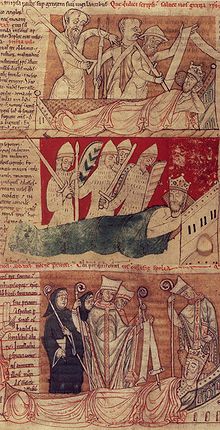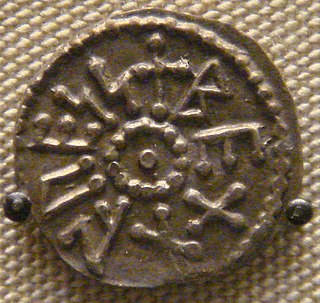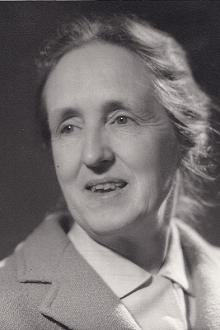
John of Worcester (died c. 1140) was an English monk and chronicler who worked at Worcester Priory. He is usually held to be the author of the Chronicon ex chronicis.

John of Worcester (died c. 1140) was an English monk and chronicler who worked at Worcester Priory. He is usually held to be the author of the Chronicon ex chronicis.
The Chronicon ex chronicis is a world wide history which begins with the creation and ends in 1140. The chronological framework of the Chronicon was presented by the chronicle of Marianus Scotus (d. 1082). A great deal of additional material, particularly relating to English history, was grafted onto it.
The greater part of the work, up to 1117 or 1118, was formerly attributed to the man Florence of Worcester on the basis of the entry for his death under the annal of 1118, which credits his skill and industry for making the chronicle such a prominent work. [1] In this view, the other Worcester monk, John, merely wrote the final part of the work. However, there are two main objections against the ascription to Florence. First, there is no change of style in the Chronicon after Florence's death, and second, certain sections before 1118 rely to some extent on the Historia novorum of Eadmer of Canterbury, which was completed sometime in 1121 – 1124. [2]
The prevalent view today is that John of Worcester was the principal author and compiler. He is explicitly named as the author of two entries for 1128 and 1138, and two manuscripts (CCC MS 157 and the chronicula) were written in his hand. He was seen working on it at the behest of Wulfstan, bishop of Worcester, when the Anglo-Norman chronicler Orderic Vitalis visited Worcester:
| Ioannes Wigornensis a puero monachus, natione Anglicus, moribus et eruditione uenerandus, in his quæ Mariani Scotti cronicis adiecit, de rege Guillelmo et de rebus quæ sub eo uel sub filiis eius Guillelmo Rufo et Henrico usque hodie contigerunt honeste deprompsit. [...] Quem prosecutus Iohannes acta fere centum annorum contexuit, iussuque uenerabilis Wlfstani pontificis et monachi supradictis cronicis inseruit in quibus multa de Romanis et Francis et Alemannis aliisque gentibus quæ agnouit [...]. | "John, an Englishman by birth who entered the monastery of Worcester as a boy and won great repute for his learning and piety, continued the chronicle of Marianus Scotus and carefully recorded the events of William's reign and of his sons William Rufus and Henry up to the present. [...] John, at the command of the venerable Wulfstan bishop and monk [d. 1095], added to these chronicles [i.e. of Marianus Scotus] events of about a hundred years, by inserting a brief and valuable summary of many deeds of the Romans and Franks, Germans and other peoples whom he knew [...]." [3] |
The Chronicon survives in five manuscripts (and a fragment on a single leaf):

In addition, there is the chronicula, a minor chronicle based on the Chronicon proper: MS 503 (Dublin, Trinity College), written by John up to 1123.
For the body of material dealing with early English history, John is believed to have used a number of sources, some of which are now lost:
Beverley, Alfred of, chronicler, and sacrist of the collegiate church of St John the Evangelist and St John of Beverley wrote a history of Britain and England in nine chapters from its supposed foundation by the Trojan Brutus, down to the death of Henry I in 1135. Alfred's chief sources, in addition to Bede's Historia Ecclesiastica de Gentis Anglorum, are Geoffrey of Monmouth's Historia Regum Britanniae, Henry of Huntingdon's Historia Anglorum, The Chronicle of John of Worcester, and the Historia Regum, attributed to Symeon of Durham.e
Æthelweard was an ealdorman and the author of a Latin version of the Anglo-Saxon Chronicle known as the Chronicon Æthelweardi. He was a kinsman of the royal family, being a descendant of the Anglo-Saxon King Æthelred I of Wessex, the elder brother of Alfred the Great.
Florence of Worcester, known in Latin as Florentius, was a monk of Worcester, who played some part in the production of the Chronicon ex chronicis, a Latin world chronicle which begins with the creation and ends in 1140.

Saint Margaret of Scotland, also known as Margaret of Wessex, was an English princess and a Scottish queen. Margaret was sometimes called "The Pearl of Scotland". Born in the Kingdom of Hungary to the expatriate English prince Edward the Exile, Margaret and her family returned to England in 1057. Following the death of Harold Godwinson at the Battle of Hastings in 1066, her brother Edgar Ætheling was elected as King of England but never crowned. After she and her family fled north, Margaret married Malcolm III of Scotland by the end of 1070.

Eadmer or Edmer was an English historian, theologian, and ecclesiastic. He is known for being a contemporary biographer of his archbishop and companion, Saint Anselm, in his Vita Anselmi, and for his Historia novorum in Anglia, which presents the public face of Anselm. Eadmer's history is written to support the primacy of Canterbury over York, a central concern for Anselm.
William of Poitiers was a Frankish priest of Norman origin and chaplain of Duke William of Normandy, for whom he chronicled the Norman Conquest of England in his Gesta Willelmi ducis Normannorum et regis Anglorum or Gesta Guillelmi II ducis Normannorum. He had trained as a soldier before taking holy orders.

Orderic Vitalis was an English chronicler and Benedictine monk who wrote one of the great contemporary chronicles of 11th- and 12th-century Normandy and Anglo-Norman England. Modern historians view him as a reliable source.
Arnulf de Montgomery was an Anglo-Norman magnate. He was a younger son of Roger de Montgomery and Mabel de Bellême. Arnulf's father was a leading magnate in Normandy and England, and played an active part in the Anglo-Norman invasion of Wales in the late eleventh century.
Historians in England during the Middle Ages helped to lay the groundwork for modern historical historiography, providing vital accounts of the early history of England, Wales and Normandy, its cultures, and revelations about the historians themselves.

This article presents lists of the literary events and publications in the 12th century.

Beonna was King of East Anglia from 749. He is notable for being the first East Anglian king whose coinage included both the ruler's name and his title. The end-date of Beonna's reign is not known, but may have been around 760. It is thought that he shared the kingdom with another ruler called Alberht and possibly with a third man, named Hun. Not all experts agree with these regnal dates, or the nature of his kingship: it has been suggested that he may have ruled alone from around 758.
Pehthelm was the first historical bishop of the episcopal see of Candida Casa at Whithorn. He was consecrated in 730 or 731 and served until his demise. His name is also spelled as Pecthelm, Pechthelm, and sometimes as Wehthelm.
Ælfgifu of York was the first wife of Æthelred the Unready, King of the English; as such, she was Queen of the English from their marriage in the 980s until her death in 1002. They had many children together, including Edmund Ironside. It is most probable that Ælfgifu was a daughter of Thored, Earl of southern Northumbria and his wife, Hilda.
The Historia Regum is a historical compilation attributed to Symeon of Durham, which presents material going from the death of Bede until 1129. It survives only in one manuscript compiled in Yorkshire in the mid-to-late 12th century, though the material is earlier. It is an often-used source for medieval English and Northumbrian history. The first five sections are now attributed to Byrhtferth of Ramsey.

The Liber Eliensis is a 12th-century English chronicle and history, written in Latin. Composed in three books, it was written at Ely Abbey on the island of Ely in the fenlands of eastern Cambridgeshire. Ely Abbey became the cathedral of a newly formed bishopric in 1109. Traditionally the author of the anonymous work has been given as Richard or Thomas, two monks at Ely, one of whom, Richard, has been identified with an official of the monastery, but some historians hold that neither Richard nor Thomas was the author.

Marjorie McCallum Chibnall was an English historian, medievalist and Latin translator. She edited the Historia Ecclesiastica by Orderic Vitalis, with whom she shared the same birthplace of Atcham in Shropshire.
Siward Barn was an 11th-century English thegn and landowner-warrior. He appears in the extant sources in the period following the Norman Conquest of England, joining the northern resistance to William the Conqueror by the end of the 1060s. Siward's resistance continued until his capture on the Isle of Ely alongside Æthelwine, Bishop of Durham, Earl Morcar, and Hereward as cited in the Anglo-Saxon Chronicle. Siward and his confiscated properties in central and northern England were mentioned in Domesday Book, and from this it is clear that he was one of the main antecessors of Henry de Ferrers, father of Robert de Ferrers, the first Earl of Derby.

The Anglo-Saxon Chronicle is a collection of annals in Old English, chronicling the history of the Anglo-Saxons.
John of Eversden or Everisden,, was an English chronicler.

Morville Priory was a small Benedictine monastery in Shropshire, England, a cell of Shrewsbury Abbey.